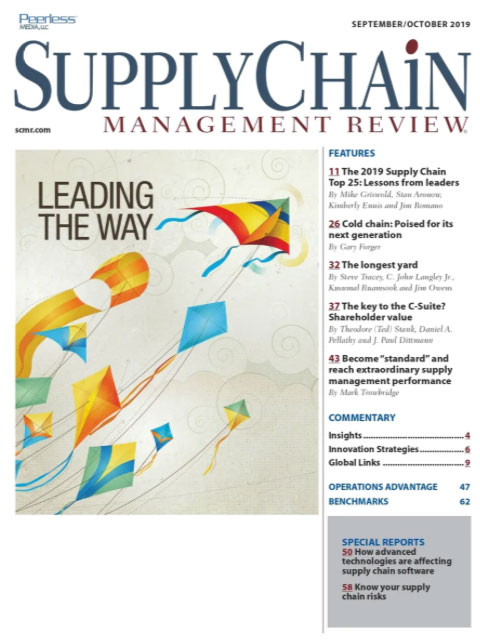Sorry, but your login has failed. Please recheck your login information and resubmit. If your subscription has expired, renew here.
September-October 2019
It’s that time of year again, when we feature the Top 25 supply chains from Gartner. What I enjoy most about this research is the window it provides into where supply chains are going next: After all, while some lead, the rest of us follow. Browse this issue archive.Need Help? Contact customer service 847-559-7581 More options
It’s that time of year again, when we feature the Top 25 supply chains from Gartner. What I enjoy most about this research is the window it provides into where supply chains are going next: After all, while some lead, the rest of us follow. Reading through I was struck not by how many of the Top 25 are implementing NextGen technologies—that’s almost a given. Rather, how their supply chains are enabling their companies’ business strategies. Indeed, Gartner’s key findings were that leaders were launching initiatives to enable personalization at scale (think lot sizes of one), leveraging their ecosystems because no one can go it alone these days and driving business-led strategies. It’s initiatives like these that drive value and revenue, rather than just focus on cost—and elevate supply chain to the C-Suite.
That theme is echoed in The key to the C-Suite? an article from frequent contributors Ted Stank, J. Paul Dittmann and Daniel A. Pellathy. Based on their research, the answer to the question is a supply chain that delivers shareholder value. They note that a handful of forward-thinking supply chain managers “recognize that supply chain improvements can be used to dramatically lower working capital and generate the cash flow to fund innovations in product and service offerings and ultimately to grow the business. Because these changes positively affect economic profit, investors reward these efforts with higher shareholder value.” Supply chain managers who can drive business-led strategies and deliver shareholder value (like Gap’s Shawn Curran who was featured last month) can get the ear of the CEO, CFO and board of directors.
Also this month, SCMR’s special projects editor Gary Forger takes an in-depth look at one of the most critical areas of supply chain management today: the cold chain. It is being transformed by external forces, such as new regulations, the labor shortage and the rise of direct-to-consumer deliveries, and internal forces like the adoption of automation, software and IoT.
Procurement professionals will want to read Mark Trowbridge’s piece on improving supply chain performance through standardization in category management. Mark is a frequent speaker at ISM and regular contributor to SCMR.

This complete article is available to subscribers only.
Log in now for full access or start your PLUS+ subscription for instant access.
SC
MR
Sorry, but your login has failed. Please recheck your login information and resubmit. If your subscription has expired, renew here.
September-October 2019
It’s that time of year again, when we feature the Top 25 supply chains from Gartner. What I enjoy most about this research is the window it provides into where supply chains are going next: After all, while some… Browse this issue archive. Access your online digital edition. Download a PDF file of the September-October 2019 issue.It's that time of year again, when we feature the Top 25 supply chains from Gartner. What I enjoy most about this research is the window it provides into where supply chains are going next: After all, while some lead, the rest of us follow. Reading through I was struck not by how many of the Top 25 are implementing NextGen technologies—that's almost a given. Rather, how their supply chains are enabling their companies' business strategies. Indeed, Gartner's key findings were that leaders were launching initiatives to enable personalization at scale (think lot sizes of one), leveraging their ecosystems because no one can go it alone these days and driving business-led strategies. It's initiatives like these that drive value and revenue, rather than just focus on cost—and elevate supply chain to the C-Suite.
That theme is echoed in The key to the C-Suite? an article from frequent contributors Ted Stank, J. Paul Dittmann and Daniel A. Pellathy. Based on their research, the answer to the question is a supply chain that delivers shareholder value. They note that a handful of forward-thinking supply chain managers “recognize that supply chain improvements can be used to dramatically lower working capital and generate the cash flow to fund innovations in product and service offerings and ultimately to grow the business. Because these changes positively affect economic profit, investors reward these efforts with higher shareholder value.” Supply chain managers who can drive business-led strategies and deliver shareholder value (like Gap's Shawn Curran who was featured last month) can get the ear of the CEO, CFO and board of directors.
Also this month, SCMR's special projects editor Gary Forger takes an in-depth look at one of the most critical areas of supply chain management today: the cold chain. It is being transformed by external forces, such as new regulations, the labor shortage and the rise of direct-to-consumer deliveries, and internal forces like the adoption of automation, software and IoT.
Procurement professionals will want to read Mark Trowbridge's piece on improving supply chain performance through standardization in category management. Mark is a frequent speaker at ISM and regular contributor to SCMR.
 SUBSCRIBERS: Click here to download PDF of the full article.
SUBSCRIBERS: Click here to download PDF of the full article.
SC
MR


Latest Supply Chain News
Latest Podcast

 Explore
Explore
Business Management News
- Strengthening customer fulfillment: Building a strategic stakeholder network
- The hard job of teaching soft skills
- Trump picks former Wisconsin congressman Sean Duffy for DOT secretary
- Made in Mexico, manufactured by China
- Retail sales see gains in October, reports Commerce and NRF
- Balancing green and speed: Home delivery insights from the pandemic era
- More Business Management
Latest Business Management Resources

Subscribe

Supply Chain Management Review delivers the best industry content.

Editors’ Picks





